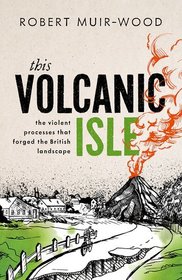
This Volcanic Isle
The Violent Processes that forged the British Landscape
- Publisher's listprice GBP 20.00
-
9 555 Ft (9 100 Ft + 5% VAT)
The price is estimated because at the time of ordering we do not know what conversion rates will apply to HUF / product currency when the book arrives. In case HUF is weaker, the price increases slightly, in case HUF is stronger, the price goes lower slightly.
- Discount 10% (cc. 956 Ft off)
- Discounted price 8 600 Ft (8 190 Ft + 5% VAT)
Subcribe now and take benefit of a favourable price.
Subscribe
9 555 Ft

Availability
Estimated delivery time: In stock at the publisher, but not at Prospero's office. Delivery time approx. 3-5 weeks.
Not in stock at Prospero.
Why don't you give exact delivery time?
Delivery time is estimated on our previous experiences. We give estimations only, because we order from outside Hungary, and the delivery time mainly depends on how quickly the publisher supplies the book. Faster or slower deliveries both happen, but we do our best to supply as quickly as possible.
Product details:
- Publisher OUP Oxford
- Date of Publication 23 May 2024
- ISBN 9780198871620
- Binding Hardback
- No. of pages368 pages
- Size 240x160x32 mm
- Weight 582 g
- Language English
- Illustrations 61 black and white figures 564
Categories
Short description:
This Volcanic Isle explores the rich geological history of the British Isles over the past 66 million years, since the disappearance of the dinosaurs. From the Isle of Wight needles to the Giant's causeway to the Sticklepath faultline in Devon, this book recounts how earthquakes and eruptions, plumes and plate boundaries, built the British Isles.
MoreLong description:
From the natural geometry of the Giant's Causeway to the sarsen slabs used to build Stonehenge, we are surrounded by evidence for the extraordinary geological forces that shaped the British Isles.
Running coast to coast through Devon is 'Sticklepath', Britain's 'San Andreas', a geological fault with the two sides displaced horizontally by several kilometres, all within the recent geological past. The Sticklepath Fault is just one manifestation of the rich tectonic history of the British region since the asteroid collision that ended the reign of the dinosaurs, 66 million years ago. Raised out of the Chalk Sea, the original Albion was a thickly forested island a thousand kilometres long, surrounded by chalk cliffs, punctuated with great volcanoes, and the site of two trial 'spreading ridge' plate-boundaries. As the volcanoes shifted west, and Greenland separated from Europe, the wind-blown volcanic ash laid the strata on which London was founded. The vertical Needles, known to every Isle of Wight sailor, are part of the northern foothills of the Pyrenees. When the collision subsided, rifting created a garland of Celtic lakes from Brittany to the Outer Hebrides.
In This Volcanic Isle Robert Muir-Wood explores the rich geological history of the British Isles, and its resulting legacy. Along the way he introduces the personalities who shared a fascination for Britain's tectonic history, including Charles Darwin the geologist, Tennyson the science-poet, and Benoit Mandelbrot, the pure mathematician who labelled the west coast of Britain a fractal icon. Here is the previously untold story of how earthquakes and eruptions, plumes and plate boundaries, built the British Isles.
This Volcanic Isle masterfully unpeels the skin of the British landscape to reveal a torrid and turbulent past. It is land famed for its geological antiquity, and yet in journeying through its last 66 million years it is the enduring youthfulness of tectonic, seismic and volcanic actions that constantly surprises and enthrals. Local places and familiar vistas are interwoven with planetary processes in a beautifully written account of how our appreciation of the natural world around us can be immeasurably enhanced by viewing it through rock-tinted spectacles.
Table of Contents:
Archi-tectonics
The Big Tilt
Age of Fire
Caught between the Plates
Age of Ice
Highland Fling
The Rocky Road
Index




